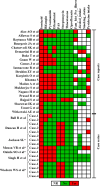Characteristics of isoniazid-induced psychosis: a systematic review of case reports and case series
- PMID: 39134879
- PMCID: PMC11458663
- DOI: 10.1007/s00228-024-03738-x
Characteristics of isoniazid-induced psychosis: a systematic review of case reports and case series
Abstract
Purpose: Isoniazid, a first-line antitubercular drug, is associated with nervous system adverse drug reactions such as seizures, peripheral neuropathy, and psychosis. This systematic review of case reports and case series aimed to characterize the demographic, social, and clinical factors associated with isoniazid-induced psychosis in patients with active tuberculosis (TB) and those who received isoniazid for latent TB infection (LTBI).
Methods: We comprehensively searched the Embase, PubMed, and Scopus databases to identify relevant studies published between the date of inception of the database and June 2024.
Results: A total of 28 studies, including 21 case reports and 7 case series involved 37 patients who developed isoniazid-induced psychosis. A higher frequency of isoniazid-induced psychosis was observed during the first 2 months of treatment, with a relatively early onset observed among patients aged 18 years or less. Delusions and/or hallucinations are the common symptoms of isoniazid-induced psychosis. Psychomotor disturbances, disorganized speech or formal thought disorder, disorganized or abnormal behaviour, and neuropsychiatric symptoms (sleep disturbances, hostility or aggression, confusion, affective symptoms, anxiety symptoms, and cognitive difficulties) were the other symptoms observed in the included studies. More than 80% of cases rechallenged with isoniazid resulted in the recurrence of psychotic symptoms.
Conclusion: Patients with TB and LTBI should be assessed for psychotic and neuropsychiatric symptoms during isoniazid therapy, mainly in the first 2 months. Further research is required to understand the impact of underlying risk factors, such as genetic predisposition and isoniazid pharmacokinetics, as well as the clinical utility and dosage recommendations of pyridoxine for managing isoniazid-induced psychosis.
Keywords: Adverse drug reaction; Isoniazid; Psychosis; Pyridoxine; Tuberculosis.
© 2024. The Author(s).
Conflict of interest statement
The authors declare no competing interests.
Figures



Similar articles
-
Isoniazid-induced psychosis.Ann Pharmacother. 1998 Sep;32(9):889-91. doi: 10.1345/aph.17377. Ann Pharmacother. 1998. PMID: 9762376
-
A systematic review of adverse events of rifapentine and isoniazid compared to other treatments for latent tuberculosis infection.Pharmacoepidemiol Drug Saf. 2018 Jun;27(6):557-566. doi: 10.1002/pds.4423. Epub 2018 Mar 23. Pharmacoepidemiol Drug Saf. 2018. PMID: 29573031
-
Suicidal psychosis secondary to isoniazid.Pediatr Emerg Care. 2002 Feb;18(1):25-7. doi: 10.1097/00006565-200202000-00008. Pediatr Emerg Care. 2002. PMID: 11862134 No abstract available.
-
Psychotic disorder associated with isoniazid.Mil Med. 1996 Nov;161(11):707. Mil Med. 1996. PMID: 8961730
-
Isoniazid-associated psychosis: case report and review of the literature.Ann Pharmacother. 1993 Feb;27(2):167-70. doi: 10.1177/106002809302700205. Ann Pharmacother. 1993. PMID: 8439690 Review.
Cited by
-
Genetic polymorphisms and adverse reactions to antituberculosis therapy.Pharmacogenomics. 2025 Apr-Apr;26(5-6):207-221. doi: 10.1080/14622416.2025.2509479. Epub 2025 Jun 20. Pharmacogenomics. 2025. PMID: 40538374 Free PMC article. Review.
References
-
- Murray JF, Schraufnagel DE, Hopewell PC (2015) Treatment of tuberculosis. A historical perspective. Ann Am Thorac Soc 12(12):1749–1759. 10.1513/AnnalsATS.201509-632PS - PubMed
-
- Bangert MK, Hasbun R (2019) Neurological and psychiatric adverse effects of antimicrobials. CNS Drugs 33(8):727–753. 10.1007/s40263-019-00649-9 - PubMed
-
- Esposito S, Canevini MP, Principi N (2017) Complications associated with antibiotic administration: neurological adverse events and interference with antiepileptic drugs. Int J Antimicrob Agents 50(1):1–8. 10.1016/j.ijantimicag.2017.01.027 - PubMed
-
- Kass JS, Shandera WX (2010) Nervous system effects of antituberculosis therapy. CNS Drugs 24(8):655–667. 10.2165/11534340-000000000-00000 - PubMed
-
- Sharawat IK, Dawman L (2021) Toddler with intermittent abnormal behavior: is it isoniazid-induced psychosis? Pediatr Emerg Care 37(1):e60–e61. 10.1097/PEC.0000000000001555 - PubMed
Publication types
MeSH terms
Substances
LinkOut - more resources
Full Text Sources

